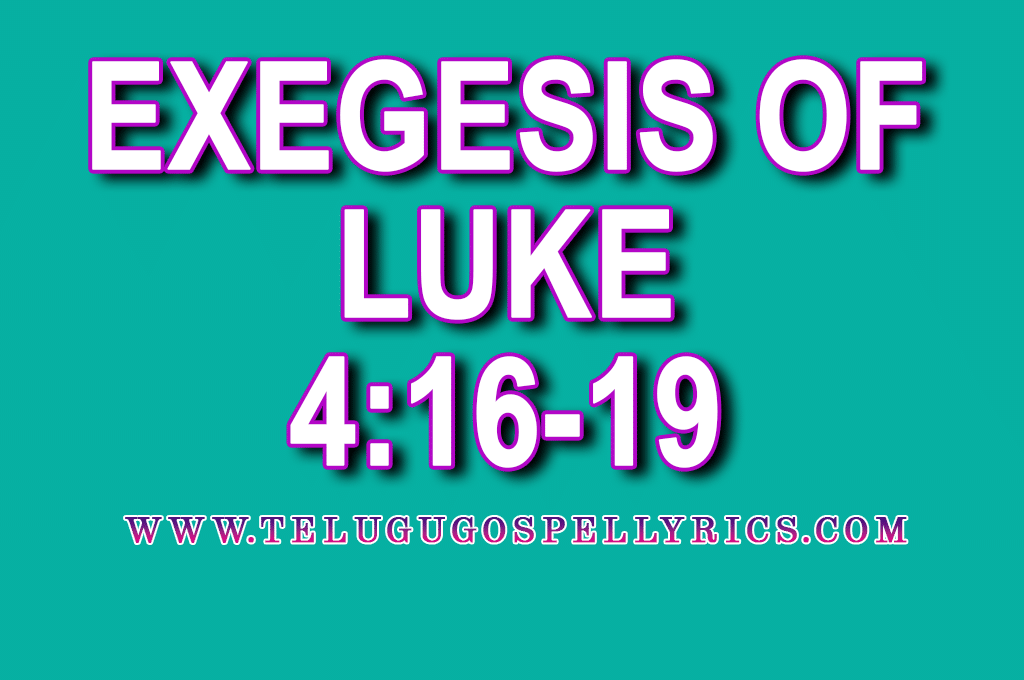Exegesis of Luke 4:16-19
1. General Guidelines for Exegesis from the Gospels
Exegeting the Gospels seems to be a daunting task. But once proper principles of exegesis are understood and followed exegeting the Gospels is a rewarding exercise. Applying newer interpretative methods or reading the Gospels from new approaches or perspectives is recommended. Therefore, every exegete can follow her/his own choice of method/criticism. However, the primary task of exegesis is to discover what the text “meant” and to bring out what it will “mean” for now. Therefore, the exegete functions as the “bridge” between the text and the context. So, her/his role becomes extremely important in order to let the Gospels speak relevantly to the present context.
Apart from the authorship and date of writing of each Gospel, exegete must first do a detail study on the background of each Gospel. This will include the following:
i. Determine each Gospel’s literary features
ii. Determine the locality involved in each of the Gospels (to whom was it written or the community from which it originated)
iii. Identify the Sitz im Leben (i.e., the Life Setting or the situation of the author and the readers including issues, problems, etc. that they were facing)
iv. Determine the purpose of writing
v. Get a general idea of the theological perspective of each Gospel
2. A Modular Exegesis from the Gospels: Luke 4:16-19
2.1. Authorship of Luke’s Gospel
The Gospel itself is anonymous and contains no accurate information which would enable us to identify its author. But traditionally it is believed that he was Luke, the ‘beloved physician’ (cf. Col 4:14; 2 Tim 4:11; Phlm 24) and a companion of Paul. That he wrote for an urban church community in the Hellenistic world is fairly certain. The Gospel according to Luke is the first of a two-volume work by the same author, Acts being the second volume (hence Luke-Acts).
What we can gather from the Gospel itself about its author is that he is interested in the Gentiles and the marginalized groups of people suggesting that he was a Gentile. However, he bases his story of Jesus in the OT, even though he does not quote the OT extensively as Matt does, his Gospel is saturated with OT terms, concepts and figures which shows Luke’s Jewishness.
2.2. Sources and Composition of Luke
Luke does not claim to be an eyewitness and confesses that he is only a compiler, claiming simply the credit of having done his best to verify the facts which he narrates. Luke’s preface (1:1-4) suggests that the Gospel is addressed to a certain Theophilus, the identity of this “God lover” is unknown to us; and we are not even sure whether he was an individual or a symbol. Verse 1 states that he is neither the first nor the only one to write down the things because “many have undertaken to set down an orderly account of the events”. Do “many” mean the other canonical Gospels? Here, most of the scholars agree that Luke is expressing his reliance on Mark as his source. Again, he says that what he attempts to do is “to set down an orderly account” which made the earlier scholars to come to a conclusion that Luke was a serious historian. In v. 2, Luke states that he bases upon the tradition of “those who from the very beginning were eyewitnesses and ministers of the word.” This verse indicates that he himself is not an eyewitness (“those who”) but what he is about to set out is genuine and authentic because the “eyewitnesses and servants of the word” who have been from the beginning of Jesus’ public activity are his sources. Thus, upon the basis of the tradition of the eyewitnesses, “many” already before Luke have undertaken to give a description of the “things” which “have been accomplished among us”. With this, Luke points to the facts associated with the life, death and resurrection of Jesus which were concluded with the resurrection and which yet continued working in the “preaching of the kingdom of God” and in the “teaching about the Lord Jesus Christ.”
Apart from what Luke says in the Prologue, Luke is believed to have made use of the Gospel of Mark and Q as basic sources in the writing of the Gospel. The Greek of the Prologue is said to be imitation of classical style that many have detected a strong influence of the LXX, for the suggestion that Luke was a Gentile convert to Judaism. But there are materials which are composed by Luke himself. Therefore, he mixes the materials taken from Mark and Q with his own compositions.
2.3. Date of Writing Luke
The Gospel itself was apparently written sometime after the fall of Jerusalem in A.D.70, since Luke 19:41-44; 21:20-24 show knowledge of that event. Most scholars, therefore, generally date Luke sometime between AD 80-100. Moreover, if Luke had used Mark which was written c. A.D. 65-70, then a general dating of A.D. 75-85 may be assigned to Luke because taking Luke too late a period of the first century A.D. may not be plausible.
2.4. Sitz im Leben of Luke
The Sitz im Leben of Luke can be inferred from his community concerns that we can surmise from his Gospel.
(i) The Problems of Parousia
Hans Conzelmann identified the pivotal problem facing the evangelist as the historical delay of the parousia. To him, Jesus and the early Christians expected the parousia to occur very soon certainly within their own generation. Therefore, Luke seeks to eradicate the expectation of an imminent end by posting a prolonged and divinely-ordained “Age of the Church.”
(ii) False Teaching
C.H. Talbert argues that the major purpose of Luke-Acts is to provide a defense against false teaching in the Church. The Gnostic system was based on an extreme dualism that projected a Docetic view of Christ. The Gnostic teachers described Christ as a spiritual being who did not actually suffer or die.
(iii) Tribulation
The tribulation that Luke’s community experienced was related to the Jews’ disastrous war with Rome where the people of God were humiliated and their Temple was destroyed and the subsequent years marked increased animosity between the Jews and the Christians with Christians mostly becoming the victims.
(iv) Jews and Gentiles
Luke’s community is certain that they faced the question of how Gentile Christianity relates to Judaism. According to Robert Maddox there is a sustained development of the theme “Israel and the Gentiles” In Luke-Acts which was a pressing concern for Luke and his community challenging the legitimacy of Gentile Christians. The question quite simply was, “who are the true people of God.”
(v) Controversies
(a) Internal Controversies
Internally Luke engages in polemic against Jewish Christians who seek to apply overly strict entrance requirements to those who want to join reconstituted Israel. These Jewish Christians are the “Pharisees” of the Gospel, who object to Jesus’ eating habits and associating with sinners and tax-collectors. Against them Luke develops his view of who are the children of Abraham (13:10-17/ 19:1-10).
(b) External Controversies
Externally, the problem Luke’s community faced are those of harassment, primarily from local Jewish Synagogues leaders (21:11-19), the problems of Peter, John, Stephen, Barnabas and Paul in Acts. As the sermons of Peter, Stephen and Paul further indicate, these problems involve the interpretation of scripture, especially how Jesus is the fulfilment God’s promise and such scripture interpretation is no small concern for mission to Jews.
(vi) Social and Economic Issues
Luke’s community consisted of both Jews and Gentiles, men and women, rich and poor. There were frictions within arising from this social and economic plurality. Therefore, Luke has an emphasis on “universal” significance of Jesus. Men and women, Jews and Gentiles, rich and poor are to treat each other as co-sharers and participants in the great salvific plan of God. The “Church” is to be an inclusive community.
2.5. Purpose of Writing
Luke does not provide any explicit purpose for his writing. But taking the entire perspective of Luke-Acts, Hans Conzelmann suggests that Luke divides time or history into three epochs–time of Israel, time of Jesus and the time of the Church. According to him, Luke and his Church found themselves in the last epoch. As such, Luke sees the Church that has come to stay in the world. Therefore proposed purposes hinge on these main points:
(i) An Apology for the Christians
During the time Luke was written, Christianity was regarded as an “illegitimate” religion. In order to correct that misplaced perception Luke wrote to “defend” (i.e., apology) Christianity and argue that it is not a disloyal or an anti-social group capable of disturbing the Pax Romana but a legitimate fulfilment of Israel’s ancient faith. The accusation on which Jesus was handed over to be crucified by the Roman Governor Pilate was on the political charge of treason (cf. Luke 23:2). But Luke affirms the “innocence” of Jesus throughout the Passion Narrative that climaxes on the Centurion’s declaration that Jesus is “innocent”, (23:47). Therefore, Luke attempts to show that just as its founder (Jesus) Christianity is politically harmless to the Empire nor Christians are anti-socials.
(ii) A Political Apology for the Romans
At just the opposite of the above point is that Luke wanted to “defend” the Romans before the Christians. Christians doubted the fairness of the Romans and blamed them for the death of Jesus. Therefore, Luke wanted to tell them that the Romans are not a threat to Christianity since they have been sympathetic to Jesus.
(iii) A Call to Revolution
Andre Trocme has suggested that Luke presents Jesus as an instigator of revolution. He sees Jesus as one who tries to revive the ancient Jewish custom of “Jubilee,” where the proclamation of a Jubilee year would allow the land be remitted, slaves would be released and capital would be redistributed as in the OT text (Lev 25; Exod 21:2-6; 23:10-12; and Deut 15:1-18; 31:9-13).
(iv) A Plea for Peace
Bringing Jesus’ “table fellowship” to the fore, J. Massyngbaerde Ford proposed that Luke’s purpose was to show that Jesus was a non-violent person who not only taught it but practised it himself. He focusses on the frequent references to Jesus as one who eats with enemies and outcasts (5:29; 15:1-2; 19:1-10), thereby admitting those people who were normally ostracized into a covenantal relationship with himself.
(v) To Provide a Sociological Legitimation of Full Fellowship for Gentiles
According to R.E. Brown, Luke’s intended purpose was to assure the Gentiles that their acceptance of Jesus was no accident or aberration but part of God’s plan reaching back to the creation, a plan that ultimately includes the conversion of the whole Roman world (which Luke will show in Acts).
2.6. Exegesis of Luke 4:16-19
(i) Wider/General Context: Jesus’ Public Ministry in Galilee (4:14-9:50)
(ii) Immediate/Narrower Context: Jesus’ Rejection at Nazareth (4:16-30)
Verse 16:
Right after His temptation by the devil (4:1-13), Jesus returns to Nazareth, His home town where He spent His childhood. As a devout Jew would, Jesus goes to the synagogue on the Sabbath to worship. In the history of Israel, synagogues emerged during the exilic period where the scattered Jews (the Diaspora Jews) worshipped because they could not go every Sabbath to the temple in Jerusalem. Synagogue worship consisted of the recitation of the Shema (cf. Deut 6:4-9), a prayer, readings from the Torah and the Nebi’im (Prophets), an exposition on the passages read and a blessing by a priest. So when Jesus is in synagogue, He is invited to read from the Prophetic books.
During the synagogue worship it was a general practice to “stand” while reading from the scriptures but to “sit down” while delivering the exposition (cf. vv. 20-21) and so conforming to that Jesus “stood up to read” when He was invited by the ruling elder of the synagogue.
The combination of “sabbath” and “custom” heightens Luke’s emphasis on the faithfulness and respect of Jesus to Jewish worship practices. Since He is the Jewish expected Messiah He conforms to their religious practices by going to synagogue worship every Sabbath.
Verse 17:
The reading that was assigned to Jesus was from the Nebi’im. It is suggested that the reader was free to choose the passage from the Prophets while the Torah was read through over a period of three years. But it is more evident that this passage was assigned for that sabbath day’s reading and the significance of the combination of the passage and the reader should be that this Isaianic prophecy’s fulfilment has arrived when Jesus stands to read it. When the “scroll” (the book) of the Prophet Isaiah was handed to Him by the synagogue attendant (cf. v. 20), He opened the passage where the following words were written. During this time there was no chapter or verse numbers assigned to the Bible and hence only “the place” is indicated.
Verse 18:
A major portion of this passage is from Isaiah 61:1-2 in the LXX. LXX is the Greek translation of the OT and among the Diaspora Jews this Greek translation was mostly used. An unmistakable emphasis of this verse is that these words written by Prophet Isaiah in the long ago is now fulfilled in Jesus as He will say it in later verses (cf. v. 21). Some of major Lukan themes are introduced in this verse: (i) empowerment by the Spirit; (ii) reversal of fortune for the social and economically disadvantaged people; (iii) holistic healing of body and spirit. There is also an emphasis on “me” and “release” in this verse making “release” as the main message of Jesus. This emphasis on “release” theme will be repeated in v. 19 also where the concept of “Jubilee” is contained. Thus Luke combines Isaiah with the book of Leviticus chapter 25 where Jubilee legislation is outlined. This combination drives home Luke’s perspective of Jesus’ mission as centred in “release” theme.
“The Spirit of the Lord is upon me because he has anointed me”. The reader can quickly connect it with the baptism of Jesus event when the “Holy Spirit descended upon him in bodily form” (3:22). Isaiah had spoken about anointing of someone upon whom the Spirit of God would rest. Jesus is that “anointed” one, i.e., the Messiah and so the Isaianic Messianic prophecy is fulfilled by Jesus “proclaiming” it through His reading.
“to preach good news to the poor…proclaim release to the captives and recovering of sight to the blind, to set at liberty those who are oppressed”. The “poor” here is a general term to include those who are economically poor, socially disadvantaged, politically powerless, etc. Some scholars, like Joel B. Green, argue that the three groups of people mentioned after it (captives, blind, oppressed) constitute the poor in this passage.
The “poor”, “captives”, “blind” and “oppressed” are the focus of Jesus’ Messianic mission. Jesus is about to bring about a “reversal of fortune” for them (cf. 1:46-55). In this Messianic age that He inaugurates, those who have been marginalized and pushed to oblivion will be brought to the centre, those who have been in chains will be set free, the hungry will be fed with good things, the lame will walk and the blind will see. The Jews looked for that day to dawn and it is now here, working and operating, in the reality of Jesus. The disadvantaged and those who did not find favour are entering into a new phase of life.
Verse 19:
Luke quotes only till the first part of verse 2 of Isaiah 61. What he omitted is also significant because Isa 61:2b talks about “vengeance of God”. Luke may be thinking that the “year of the Lord’s favour” and the day of God’s vengeance are mutually exclusive. “The year of Lord’s favour” is the original reading in Hebrew which refers to the Messianic age.
The combination of “release” theme and “the year of the Lord’s favour” brings out the Jubilee concept of Lev 25. According to Lev 25:10, the year of Jubilee is “the year of release.” Every fiftieth year the slaves were to be set free, properties to be returned to the original owners, debts would be cancelled. Luke presents Jesus’ opening address at Nazareth on that important day “Sabbath” and from the “synagogue” as an announcement of the final Jubilee, the new era of salvation, the breaking-in of God’s kingdom.
This passage is aptly called as the “Nazareth Manifesto” because what He announced from the synagogue at Nazareth is what Jesus will do throughout His ministry. His mission of release will involve conflict with the Satanic forces by which He will release those bound by Satan (cf. Luke 13:16). He will break the oppressive social, cultural and religious traditions in order to set free who are enslaved by them. Thus this passage functions as the proclamatic announcement of Jesus’ program.
Bibliography
Jamir, Menjiwapong. Understanding the Jesus Movement in the Gospel Traditions. Kolkata: SCEPTRE, 2013.








